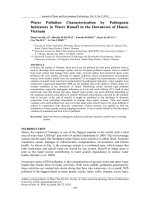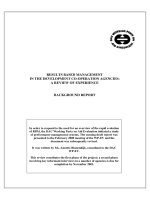Water Management in the Netherlands pptx
Bạn đang xem bản rút gọn của tài liệu. Xem và tải ngay bản đầy đủ của tài liệu tại đây (2.86 MB, 84 trang )
Rijkswaterstaat
Water Management in the Netherlands
Water Management
in the Netherlands
This is an edition of
Rijkswaterstaat
For more information visit
www.rijkswaterstaat.nl
Telephone +31 (0)800 - 8002
(toll free number, in the Netherlands only)
February 2011 |
| Rijkswaterstaat2
Water Management
in the Netherlands
| Rijkswaterstaat2
Water Management in the Netherlands | 3
Preface
Having the right amount of water for water users, at the right time, in the
right place, and at socially acceptable costs is one of the key targets for the
Ministry of Infrastructure and Environment.
Today’s ground rules for the distribution of water in the Netherlands
originate from the 1980s, more specifically from the second Policy
Document on Water Management. At the time, the entire water
infrastructure was reviewed. The conclusion was that large-scale
investments in the water infrastructure were not necessary and that good
management would suffice to optimise the benefits of our water
distribution system.
Our infrastructure and the ground rules still suffice, but the capabilities
have been stretched to the limits. Climate change and sea level rise prompt
a re-examination of our water management. The resilience of the main
water system, the water infrastructure and the ground rules are up for
reconsideration. Water usage has also changed and new facilities are
needed. We can only respond to the forecasted climate changes if we are
fully conversant with the way the main water system works. The question is,
are we still familiar with the background, the operation and the rules of our
water management? This booklet seeks to contribute to answering that
question. This is also an excelent opportunity to offer our collegues from
abroad an overview of the specific situation of water management in the
Netherlands, a country that would not be inhabitable without our flood
defences and water management structure.
I hope you will enjoy reading it.
Luitzen Bijlsma
General Director, Rijkswaterstaat, Centre for Water Management
| Rijkswaterstaat4
Water Management in the Netherlands | 5
Preface 3
Introduction 7
1 The development of water management in the Netherlands 11
The history of the formation of the Netherlands 11
The history of water management in the Netherlands 13
2 System and functioning 21
Management of the freshwater element of our water management system 22
Components of our water management system: 26
– The Meuse 26
– The Rhine and its distributaries 27
– IJsselmeer area 31
– Southwestern Delta 31
– Regional waterways 36
Limits to water management 36
3 Safety 37
4 Excess of water 41
5 Water shortages and drought 47
6 Salinisation 53
7 Water quality 59
8 Future developments 65
Physical and societal changes 65
Consequences of climate change for water management 69
9 Towards ‘climate-proof’ water management 71
10 The Water Act and its legal instruments 75
Publication information 80
| Rijkswaterstaat6
Water Management in the Netherlands | 7
Introduction
Water management in the Netherlands is a complicated issue. Also,water
distribution throughout the country is far from straightforward. The
challenges for water policy makers are significant and the discussions about
these challenges frequent. That is precisely why it would be practical if
the parties involved could share an unequivocal body of knowledge and
a vocabulary that everybody understands.
As the work of many water management authorities and water users is
usually limited to only one part of our water system, it is oen difficult to
understand the system as a whole and all its interconnections. There is
also sometimes a distorted perception of the possibilities that exists in
channelling water. The need to have an overview of our water management
system and its functioning is indispensable in present discussions. It is
important to know why things are organised the way they are and to
understand the aspects closely related to the distribution of water, such as
safety, excess of water and shortages, drought and salinisation. It is also
important to know which issues and bolenecks to expect if climate
change persists.
This booklet describes water management and water distribution in the
Netherlands as well as the problems related to flooding, water shortages,
safety, drought and salinisation. The description of our water management
system includes a short history of the geological creation of the Netherlands
and an account of the interventions that took place over the centuries to
protect the country from highvolume river discharges or storm tides.
Land reclamation and other hydraulic engineering projects, such as the
excavation of channels to the sea and the canalisation of rivers, are also
briefly discussed.
We also look at water distribution, focusing on the main water system,
the regional system and the interaction between them. Water distribution
under normal circumstances is distinguished from water distribution in
the event of flooding or water shortage.
| Rijkswaterstaat8
The relation with safety and salinisation is explained as well. Finally,
we discuss the current bolenecks and the problems we can expect as
a consequence of climate change and soil subsidence. Where relevant,
the various themes will be related to the designated users.
This booklet may be used by everyone involved in organisational issues
of water management in the Netherlands: water management authorities
and policy staff of municipal councils, provinces, water boards and central
government, as well as people who use our water system, and other
interested parties. The aim is to provide basic knowledge on water
management and water distribution in the Netherlands. Hopefully this
knowledge and information will contribute to a clear discussion on solving
current and future bolenecks. We hope it will also contribute to insight
and understanding of those abroad, who are interested in the particularities
of water management in the Netherlands.
Water Management in the Netherlands | 9
| Rijkswaterstaat10
Water Management in the Netherlands | 11
1 The development of
water management in
the Netherlands
The history of the formation of the Netherlands
At the end of the last Ice Age, around 10,000 years ago, the North Sea was
a large lowland plain. As temperature increased the sea level rose and aer
a few thousand years, the North Sea was on the doorstep of what we now
call the Netherlands. River water came to a halt behind barrier bars that
the sea had created. Silt seled and plants flourished in the warmer climate,
forming a layer of peat on windborne sands deposited during the previous
period.
For centuries these layers of peat accumulated, particularly where the
barrier bars formed a continuous line, as it did in Holland. However, storm
tides washed away entire areas of peat, aer which marine clay deposits
were formed. This happened mostly in the southwest of the Netherlands.
In the east and south the coarse and fine sand deposits from the ice ages
still occur on the surface. Here we also find the hilly areas of the Veluwe,
the Utrechtse Heuvelrug, the Hondsrug and Salland, which are formed
by lateral moraines le behind by the ice ages. These high grounds are
criss-crossed by a multitude of streams that provide natural drainage.
In the north we also find boulder clay.
| Rijkswaterstaat12
7000 BC 5500 BC
This mixture of boulders, gravel and loam was so heavily compacted by the
glaciers of the last ice age that it became impermeable, which has its effect
on today’s water management.
Water Management in the Netherlands | 13
The history of water management in the Netherlands
Living on the edge of land and water offers many benefits, which is why our
ancestors stayed here despite the intrusive sea, trying to learn to live with
water. Excavations near Vlaardingen in the late 1990s proved that water
management was already part of life before the Common Era began.
Dams, sheet piling and culverts were uncovered that are clearly indicative
of water management interventions. People in the north erected artificial
dwelling mounds called terps several centuries before the Common Era
began.
Gradually, we became more enterprising. The Middle Ages saw the
reclamation of the peat bogs. Channels and ditches were dug from the
levees into the elevated bogs in order to drain them. As an unintended
effect, exposure to air caused the bogs to set and oxidise.
While this was a slow process, in time the surface level dropped until it
lay beneath the level of the river on the other side of the levee. Dikes and
mills became necessary to drain the excess water into the rivers.
In the southwest, the bogs were not drained but excavated for their salt
deposits. This type of surface level reduction gave easy access to the
sea: large parts of the bog were washed away, for instance during the
St. Elisabeth Flood of 1421, which created the Biesbosch. Large estuaries
were formed around the cores of islands.
In the north, this had already happened several centuries before. Here the
sea had breached the barrier bars in 1170, washing away the bog situated
behind them, and thus creating an internal saltwater lake: the Zuiderzee.
Shortly aerwards, in the 13th century, the inhabitants of the salt meadows
in Groningen and Friesland decided to link the mounds or ‘terps’ on which
they lived by building a series of dikes.
Even aer the Middle Ages, sea levels continued to rise and land continued
to subside. Dikes had to be raised continually. But water management at
times also took the offensive: in the early 17th century, we started draining
the lakes and ponds that had been created by extracting peat. The last of the
inland lake reclamation projects, Haarlemmermeer, was drained around
1850. By then, powerful steam-driven pumping stations had been developed
that enabled us to drain this large lake.
| Rijkswaterstaat14
Soil map of the Netherlands: high grounds with wind-borne sand deposits drain into low-lying
grounds with Holocene deposits.
Water Management in the Netherlands | 15
Diking in the southwest and north (the Dollard) reclaimed large stretches
of land from the sea, undiscouraged by disastrous setbacks in the form of
periodic storm surges. The area along the major rivers of the Netherlands was
also subject to regular flooding, oen caused by ice dams: ice floes snagged
on the shore, impeding subsequent floes until the blockage became so great
that the water forced its way over or through the dikes.
In the course of the 17
th
century, the Waal became the main distributary of the
Rhine. Almost 90 percent of the Rhine’s water discharged through the Waal
to the sea. This drastically reduced the discharge of the Rhine itself and of its
other branch, the IJssel. In order to stop this process, as well as for military
and socio-economic reasons, the Pannerdensch Kanaal was dug in 1707.
The succession of evermore powerful water-related interventions resulted in continual
subsidence of low-lying areas of the Netherlands, while the sea level continued
to rise ever faster (mean sea level [m.s.l.]).
| Rijkswaterstaat16
How the Pannerdensch Kanaal restored the discharge through the Neder-Rijn and IJssel.
In the 18
th
century, the rivers started to have difficulties discharging into
the sea. The Maasmond at Brielle silted up and shallows were also formed
upstream. Yet it would still be another century before this was corrected by
river intervention works.
The 19
th
and 20
th
centuries saw more drastic interventions, such as the
digging of the Nieuwe Merwede, the Bergsche Maas and the Nieuwe
Waterweg, and the construction of weirs in the Neder-Rijn designed to
create a different distribution of the Rhine’s water over its distributaries.
The Netherlands earned international renown with the Zuiderzee Project,
which began with the Afsluitdijk (1927-1932) and the reclamation of the
Wieringermeer, the Noordoostpolder, Oostelijk Flevoland and Zuidelijk
Flevoland. Equally impressive is the Delta Project, built in response to the
disaster that hit the southwest Netherlands in 1953. The Delta Project in
particular confirmed our reputation as controllers of the sea, especially
once the planned dam in the Oosterschelde was altered in such a way that
the sea will only be kept out if there is the threat of a repeat of the 1953
disaster.
Many of the interventions, however, have a downside which we only
started to understand in retrospect such as, for example, the ecological
consequences of the Delta Project. This understanding was incorporated
into the integrated water management policy launched in the 1980s.
Meanwhile, all these interventions have caused us to forget that the sea
actually intended to continue shiing our coastline further eastwards.
Where it would have ended up by now is difficult to say.
Pannerden
Pannerdensch Kanaal
Schenkenschans
Lobith
Arnhem
Waal
Aerdt
Pannerden
Schenkenschans
Lobith
Arnhem
Waal
Aerdt
Water Management in the Netherlands | 17
The intrusion of the sea would have been counteracted by the rivers,
which would have continued building up their deltas. But evidently
the Netherlands would have looked very different had these interventions
not taken place.
Fact is that the coast now lies where it is. And that we decided in 1990 to
try and maintain the coastline there. This is why we have been so busy ever
since with sand replenishments, both on the beach, the foreshore and in
the lioral zone. Moreover, at the turn of the millennium some events
occurred that turned our views on water management upside down. High
discharge volumes from the rivers Rhine and Meuse in 1993 and 1995 led to
the Space for the River programme. In addition, exceptional droughts in
2003 and early 2005 underlined the importance of designating areas where
water can be stored as a buffer capacity.
Southwestern Delta below sea level (dark blue). Right: situation in the event of ooding;
le: situation in the event of ooding if no interventions had been made in our water system.
| Rijkswaterstaat18
Water Boards
In the early Middle Ages, the western part of the Netherlands was a boggy
peatland. For people to work and live on that land, it had to be drained.
In those days, the villagers did that themselves by digging a ditch, building
a dam or constructing a dike. From the 11
th
century onwards, this gradually
changed. The people who owned the land were oen no longer villagers
but large landowners who lived in cities, castles or estates. Moreover,
there was a growing insight that the construction of dikes and water
drainage were maers that went beyond the realm of a village.
In the 13th century, people with common interests in safe water
management formed co-operatives, resulting in the rst water boards.
Their co-operation not only involved working together, it also implied
participation in governance, which makes the water boards the oldest
form of democratic government in the Netherlands. The water board
Hoogheemraadschap van Rijnland, established in 1232, is the oldest water
authority that is still in function.
There used to be several hundred water boards, but in the last century
their number has been reduced considerably. Nowadays there are 26 le.
Rijkswaterstaat
At the end of the 18
th
century, parliament decided to establish a powerful
central organisation to prevent the country from being ooded by the sea
and rivers. Shipworms were aacking the wooden seawalls and
quaysides, harbour mouths were silting up, and ice dams were causing
ooding. Countermeasures were taken, but they oen only provided
solace on a very local scale and caused new problems elsewhere. It was
time for centralised water management on a national level. On March 27,
1798, an ‘Agency for Public Works and Water Management’ was
established, comprising a president, an assistant and a draughtsman.
Nowadays Rijkswaterstaat is the implementing agency for the Ministry of
Infrastructure and Environment. Rijkswaterstaat administers the national
road network (3,260 km), the national waterways network (1,686 km) and
the water system (65,250 km
2
), including the Dutch part of the North Sea.
The legal instruments at the diposal of our water authorities are
presented in chapter 10.
Water Management in the Netherlands | 19
Overview of the area administered by the 26 regional water boards.
| Rijkswaterstaat20
Bifurcation point (‘T-junction’) at IJsselkop, seen from the south.
The ship is approaching from the IJssel.
Water Management in the Netherlands | 21
2 System and
functioning
The Netherlands could be considered as a gateway for water. All the water
that is carried across its borders by streams and rivers must be discharged
into the sea. The same applies for rainwater, which makes its way to the sea
overland or underground. In the east and south, this happens naturally.
Due to the relief of the land, water on high ground finds its own way down.
But in the flat low-lying areas that also lie below sea level, water needs a
helping hand.
We gradually tried to turn this gateway into a control panel: a pumping
station here, a lock there, dams, dikes and weirs everywhere. This has
resulted in a mosaic of rivers, canals, lakes and (dammed) estuaries,
interlaced with a system of ditches, town canals and channels. Generally we
manage the operation of our main water system quite well. We direct water
from the Rhine and Meuse to locations of our choice. A substantial amount
is stored in Lake IJsselmeer, so that it can be used later on for the
production of drinking water, irrigation purposes and much more. We make
sure that there is sufficient water in the canals to allow shipping to continue
and we use it to combat saline intrusion of groundwater and to keep
seawater at bay.
| Rijkswaterstaat22
Management of the freshwater element of our water
management system
However small our country is, it still is part of four international river
basins: Rhine, Meuse, Scheldt and Ems. All the water that flows down
these rivers passes through our country on its way to the Wadden Sea and
the North Sea.
As this booklet focuses only on the freshwater element of these river basins
and on the transitional area (the southwestern Delta), the Scheldt and Ems
will not be discussed. The discussion of our water management system will
address the following:
rivers with accompanying canals in the same river basin,•
IJsselmeer area,•
southwestern Delta, and•
the smaller, regional waterways on high grounds and in low-lying areas. •
In order to understand how our water management system works, the water
systems themselves need to be explained. A water system comprises various
components which interconnect to a high degree, particularly in the water
management system of the Netherlands. They influence each another, they
are co-dependent and moreover they are sensitive to transfer of problems
related to water quality and quantity. To understand that
interconnectedness properly, this paragraph will first describe the nature
and character of the various components.
Water from high grounds ows to the sea as surface water as well as via groundwater streams.
Water Management in the Netherlands | 23
High grounds
Rain that falls onto high grounds partly infiltrates where it fell, while the
remainder flows to lower-lying areas by way of streams. The infiltrated water
also seeps down, which causes marshland to develop at the foot of the high
grounds. These areas react differently in summer and winter. In summer,
the groundwater level is low as a result of the evaporation surplus, which
causes the ground to absorb most precipitation, and run-off is limited.
In winter, the soil is saturated and rainwater is discharged immediately.
River
A river can be fed by meltwater, precipitation and groundwater. In summer
(with zero or only a small precipitation surplus and lile meltwater),
the river stream is narrow. In times of a large precipitation surplus and/or
a lot of meltwater, the river can become so wide as to cover the entire flood
plains (the area between the summer dike and the winter dike).
The ‘river system’ component.
Polder
A polder is an area that is protected from outer water by a dike and that has
a controlled water level on the inside of the diked area. Any water entering
the polder (rain, seepage water) that is not used or stored, has to be pumped
out. To do this, the water is first pumped into the polder outlet.









